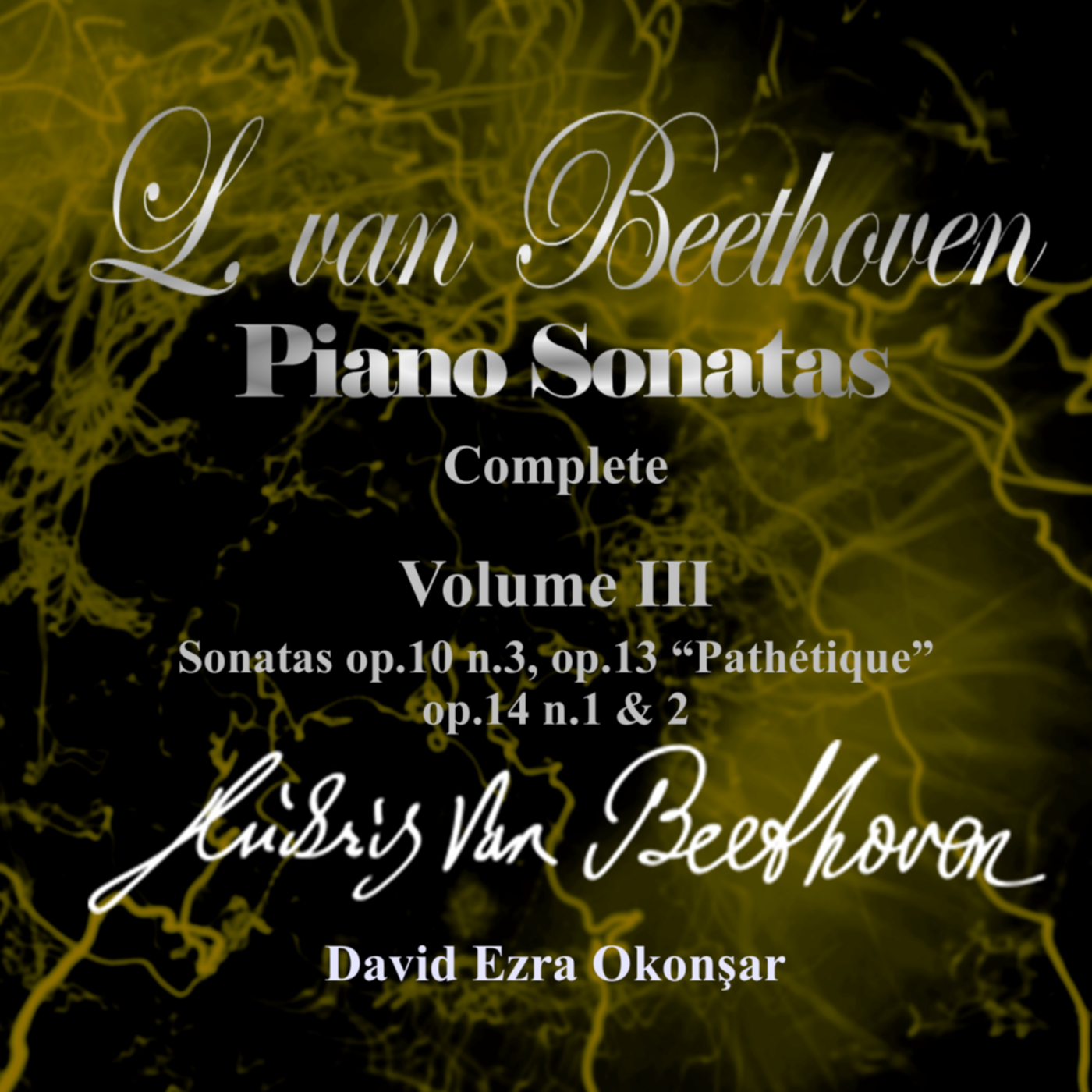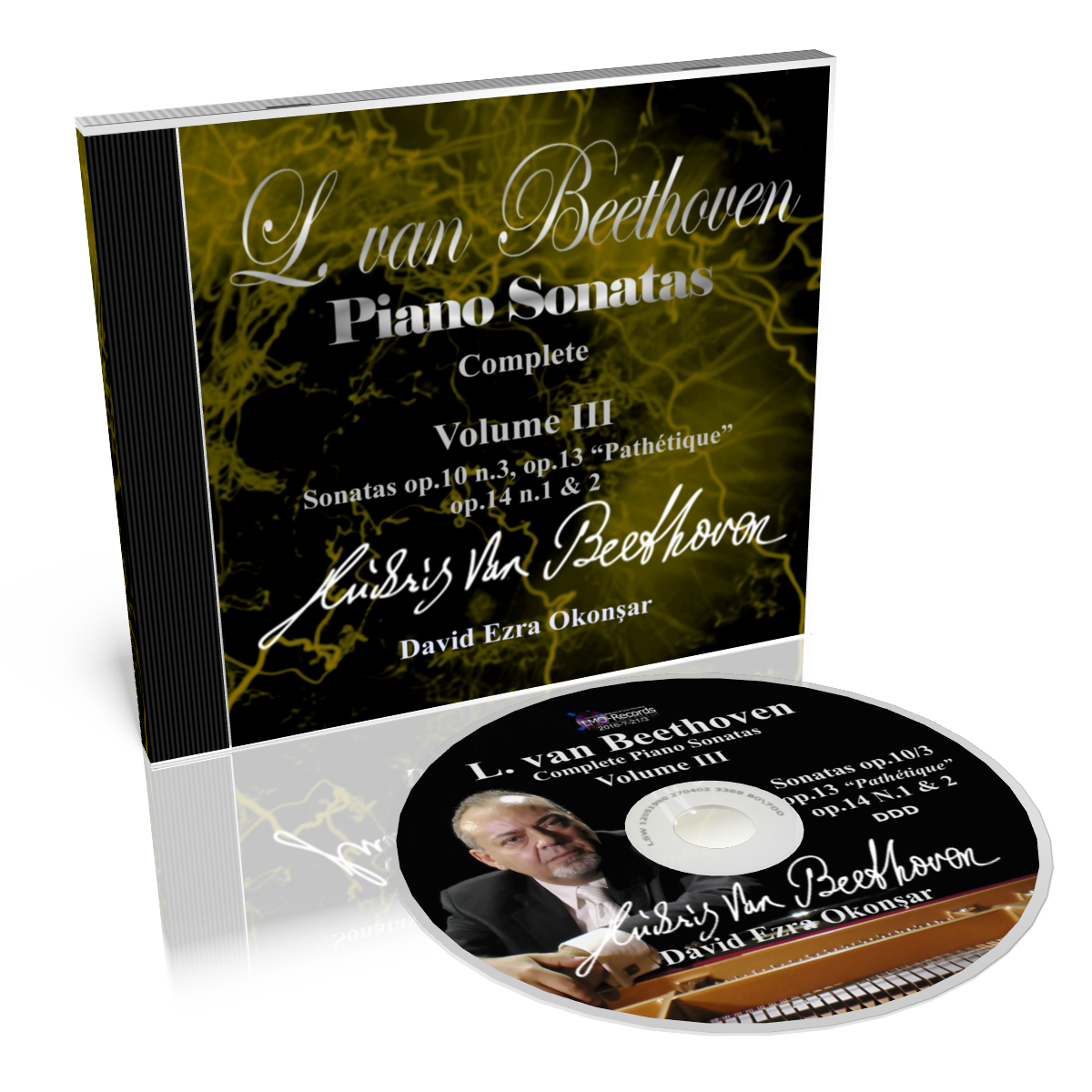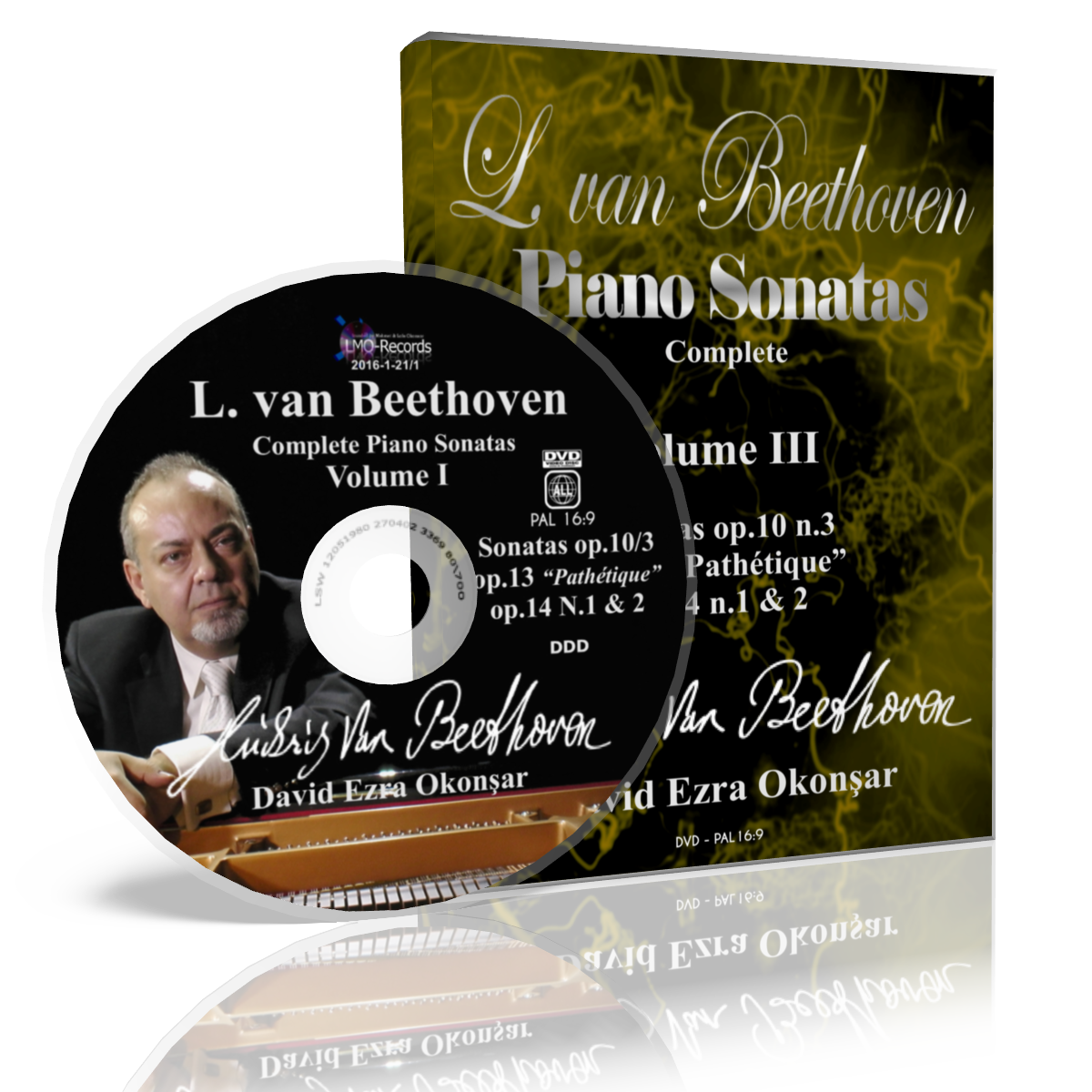
L. van Beethoven
Piano Sonatas VOL. 3
op.10 N.3, op.13 "Pathétique",
op.14 N.1 & 2
Volume 3 of the series:
The Complete Piano Sonatas by Ludwig van Beethoven



|
Beethoven Piano Sonatas op.13 "Pathétique", op.14 N.1
& 2.
Sonata N.7 in D major op.10 n.3Volume 3 of the Complete Series by David Ezra Okonsar The D major Sonata is the longest and the most elaborated Sonata of the opus 10 series. Here, Beethoven gets back to the four movement form: fast - slow - Scherzo or Menuet - fast. The two preceding Sonatas, op.10 N.1 and N.2 have only three movements, this Sonata also features the lengthiest Menuet since opus 7. The slow movement "Largo e mesto" is the most characteristic part of this work. Some twenty eight years later, the composer will say to Schindler: "Everyone will feel in this Largo the particular state of a soul, victim of melancholy, with many different nuances of light and shadow." The second movement, as a masterpiece of the pre-romantic piano literature, features the composer's all future elements of piano scoring and will remain one of his most sublime pages. I. Presto This first movement has been too often regarded as a "prelude" to the following Largo, but this assumption is very shallow indeed. The first movement is very brilliant and virtuoso but it is far from being superficial in nature. Masterly crafted and structured, the Presto has one uncanny unity. Jorg Demus beautifully described it: "this Presto is so solid and tight that it has no equal in the literature. It may be seen as a paradox because a "light" and sort of "divertimento" material is being treated in the most architectural manner." Even though the "divertimento" qualitative seems to me out of context for any of Beethoven's work, I can only agree with the rest. The movement in its whole is fully "architectural" in a rock-solid fashion and at the same time, beautifully sets the ground for the Largo. II. Largo e mesto "Mesto" means sad. The bare bones expression of the inner feelings of the young composer. By its elaboration and sheer length this movement supersedes all slow Sonata movements composed by Beethoven until then. "Where is the theme of this movement?" asks Andre Boucourechliev and answers "everywhere, because with Beethoven one should not seek the theme in the beginning or within a melodic form. The "theme" here is a rhythmical motion of two times three eights which emerges in all different ways, with changing relationships in the fields of harmony, melody, dynamics, durations, weight and even silences. Starting from this "cell" or this "matrix" the imagination escapes towards the most distant universes and meets the most unexpected, the newest." Regarding the quoted idea of a "cell", one can point out the diminished-fourth interval so characteristic. It is also appearing, very evocatively at the end of the movement. III. Menuetto The connections between movements in a Sonata are gradually becoming a crucial or even an obsessive idea of Beethoven. It is interesting to analyze the end of the slow movement in relation to the beginning of the Menuetto. The Largo ends with the tonic note: D, alone at the low end of the keyboard. The Menuet starts, at the right hand with A and then F-sharp, thus gradually creating the D major chord on top of where the preceding movement left: tonic note D. Indicated "dolce" it brings very effectively "light" and "warm" after the preceding Largo. Sort of consolation or as Alfred Brendel said: "a balm over a wound". A kind of cheerfulness appear in the very animated Trio. IV. Rondo, Allegro "Hide-and-seek" game according to Alfred Brendel. Jorg Demus, on the other hand points out the strange similarity with the beginning of the first theme of the first movement (D - C-sharp - B - A - C-sharp) and the beginning of this movement where the same intervals are presented in inversion: F-sharp - G - B, with the fourth note missing. Presenting the theme "unfinished" or as a "question mark", the discourse continues interrupted with silences, with "fake" repeats and incomplete runs. The listener is like "played" with. "Normal", i.e. "logical" expectations according to classical period musical syntax are always contradicted. The tonal centers also seem to slide continuously even at the very end of the movement and the coda seems to be a lengthy "reverence" before dodging. Sonata N.8 in C minor op.13 "Pathétique" The title "Pathetique" (or "Pathétique", "Pathetic") while not given by Beethoven himself, was agreed and even used by the composer referring to this famous composition. The Sonata was composed in the years 1798 and 99 and published by Eder in Vienna as "Grande sonate pathétique pour le clavecin ou piano-forte composée et dédiée a son Altesse Monseigneur le Prince Karl von Lichnowsky." This very popular work is the summit of Beethoven's piano works composed up to 1800. It is also the second time the composer uses the key of C minor which is very evocative for him. He will be using that key once more, only at the ultimate Sonata N.32, opus 111. Also characteristic in this Sonata is the slow beginning "Grave". Far from being a "prelude" it is, to quote César Franck, "the cyclical entity (cell) which will project on the whole composition." Even though the idea of a slow introduction has been used before, Beethoven gives to it such a dramatic power that no listener can remain unaffected. Right after its publication, the "Pathétique sonate" became an immense success. I. Grave - Allegro di molto e con brio The three notes: C - D - E-flat following the "forte-piano", C minor chord and forging this introduction's theme will also appear as the core of the theme of the final Rondo. It is repeated with variations all through the introduction with an orchestral scoring. The fortissimo chords roughly interrupting the melodic evolution set the stage for the drama. A glissando-like chromatic down scale projects into the Allegro di molto e con brio which is made of two themes. The first is an almost straight raising scale of C minor harmonized on each note and presented over a timpani-like, tremolo, left hand part. The other is also a minor key theme with incisive "mordents" which can hardly be called "embellishments". The term "mordant" (biting) if taken literally best describes those "ornaments". The ending of the movement which re-uses the introductory elements of the Grave, but the powerful forte-piano chords now replaced with silences is a dramatic climax which plunges again into the first Allegro theme and concludes with a brusque coda. II. Andante cantabile The second movement is a gracious "lied" with a number of distinct intermediary parts. The theme's specific contour is very close to the Adagio theme of Mozart's K 457 C minor sonata. All through the movement, the left hand seems to positively hold back the right hand from going to higher keyboard ranges. Even in the serene A-flat major key and with the use of the warm middle keyboard range with a beautifully balanced melodic contour, the second movement delivers only a partial relief within the overall tragic atmosphere of the entire Sonata. III. Rondo: Allegro The very gracious theme of the Rondo, seems to float over a dramatic landscape. Dark and tumultuous sections, sharp and incisive fortissimo chords intervene in each section. Only the second couplet, a "fugato" theme with perfect fourth intervals, seems to soothe the dramatic discourse which soon takes over in an even more boisterous way. Sonata N.9 in E major op.14 n.1 After the tumultuous Pathetique Sonata come two short and lovely Sonatas filled with fascinating grace. Although they may seem "easy" to play, the Schubert-like discourse requires a great amount of mastery to render perfectly. They were first published in 1799 by Mollo, music publisher in Vienna and dedicated to the Baroness Josefa von Braun. The E major one, opus 14 n.1 has been transcribed for string quartet by Beethoven himself. I. Allegro An euphoric and graceful climate is created by the first theme's contour made of perfect-fourths intervals. The development travels through A minor, C major and E minor and all thorough the movement emerges an alluring finesse. II. Allegretto The second movement is a kind of "Scherzo" in three parts, with a "maggiore" section in C major. Far from being a traditional Menuet, neither a scherzo, it looks more like a romantic ballade. It reveals an obvious string quartet type of ecriture. III. Rondo: Allegro commodo The candor and naiveté of this Rondo theme does not mask an inner joyful energy. The movement is throughout happy, even careless. Sonata N.10 in G major op.14 n.2 This Sonata which is composed at the same year and with the same dedication as the preceding one, has even more glistening and radiant grace. The conclusive Scherzo, especially has a strikingly uplift spirit in it. I. Allegro Admirably singing style sixteenth notes make for the affable theme. Bird-song like repeated notes (remember the Pastorale symphony) and running down scales with thirds remind us of Mozart or even Cimarosa. An idyllic feeling overwhelms the listener with fluid runs of thirty-eights. II. Andante The second movement, Andante, is a series of variations probably composed before the other two movements. The "Alla breve" indication reminds us that the tempo must be (at least) flowing. The theme is given as staccato chords in a kind of march-like spirit. A well-groomed and may be slightly satiric march. From the three following variations, the first and the last ones mutate the staccato theme into sinuous legato figures. The movement which may be simultaneously serene and vagabond concludes with a surprising forte tonic chord. III. Scherzo: Allegro assai The finale is actually a well-shaped Rondo, but it is appropriately named "Scherzo" due to its character. The teasing aspect is so preponderant all through the movement that titling this "Rondo" would have lessened the importance of that essential feature. What else than a binary-time (two beats long) motive, [B-C-D] moving, bouncing inside a ternary-time (three - eights) signature could have created that jesting feature? This makes for the permanent feeling of an improvisation, accentuated by rests and fermata (held) chords. Two "trios", one delicately melodic and lyric, the other in the manner of a land-lied (Landler) bring an ending soft, abrupt and at the low range of the keyboard which seems to close this game with a feign dignity. |
||||||||||||||||||||||
|
|
||||||||||||||||||||||
|



